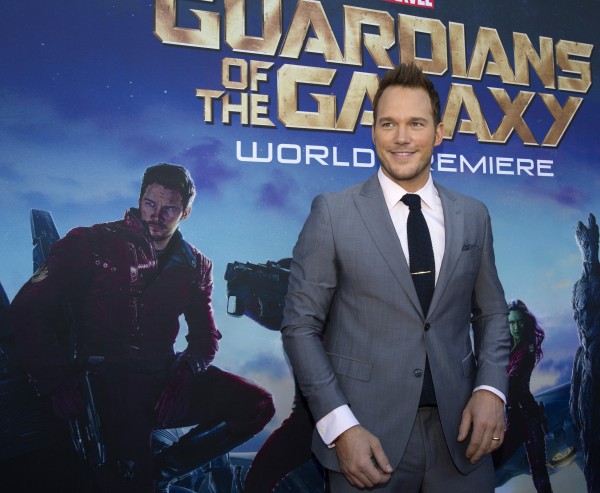Critics Question Hollywood's Muscle-Man Addiction
| David Perry | | Aug 19, 2014 08:59 PM EDT |
(Photo : Reuters) Chris Pratt's transformation from fat to fab has some questioning how he did it.
Magazines, models, and actresses have long been savaged by critics for presenting unrealistic standards of female beauty. But those same critics all but drown in their gushing praise of men who attain equally improbable muscle-god physiques and do so in record time. Some are quietly beginning to ask why that is.
Like Us on Facebook
Editor Oliver Bateman, writing for MadeMan.com, takes on the issue of hypertrophy in Hollywood.
He openly questions if Hugh Jackman's Wolverine physique is truly the result of simple diet and exercise, or if the open secret of rampant steroid usage among Tinseltown's male population came into play. Like women's magazines glowingingly recommending this or that work-out regime or diet pill while conveniently skipping a surgical procedure, Bateman observes how men's magazines tend to breeze over the fact that many actors could not get or keep their money-making builds if steroids was not involved.
"Their shining examples tantalize us with the promise of deliverance through diet and exercise," Bateman notes, "but how many stars reached these heights in a manner that wouldn't have caused them to run afoul of Major League Baseball's drug policy?"
He points out the transformations of Henry Cavill (for Man of Steel), Aaron Eckhart (for I, Frankenstein), and the almost fantastical transmogrification of Chris Pratt, who went from an overweight buffoon on "Parks & Recreation" to a Herculean hero figure in Guardians of the Galaxy, are as impossible for "real" men to attain as women trying diet their way to Salma Hayek or obviously "done" Raquel Welch.
More over, while tabloids can preach concern over a number of issues for an actress getting too thin, rarely do they do they show the same anxiety when a man's shape begins to fluctuate.
Case in point is Ryan Reynolds. During his tenure on the 1998 - 2001 sitcom "Two Guys, A Girl, and a Pizza Place," much of the comedy revolved around the actor's thin frame. Jump to 2004 and the movie Blade 3 and the formerly reedy Reynolds had put on so much muscle many of his fans didn't recognise him. Rather than be asked how he pulled off the change, he was heralded as Hollywood's latest sex-symbol. That his physique swings from shape to shape movie to movie is never discussed critically.
Bateman is careful to distinguish the difference male actors and athletes. Lance Armstrong and Barry Bonds saw their public images go down in flames when performance-enhancing drug charges took hold and the public learned they achieved greatness through chemically cheating their way to the top. But as actors are not necessarily competing in a sports forum, they do not risk the same fate. Hollywood does not test for steroids among its players and never penalizes.
When an actor is caught in the act, as Sylvester Stallone — who is stuck with his muscle-man image even at the unlikely age of 68 — was caught smuggling human growth hormone by Australian authorities at Sydney Airport in 2007, that he took it was discussed by some, but that he was caught overwhelmingly dominated the press.
Bateman laments that body image now seems to be galloping out of control on all fronts.
"In an age of ostensible openness, we seem more confused about images and bodies than ever before," says Bateman. "Men are women find themselves faced with an endless barrage of trompe-l'œil visuals for which explanations are rarely given."
He presses for simple open dialogue. "The truth, if it is indeed out there," he writes, "will set us free to respect and admire our own bodies."
Tagshollywood, steroid, actor, Chris Pratt, Henry Cavil, Oliver Bateman, Aaron Eckhart, Lance Armstrong, Barry Bonds
©2015 Chinatopix All rights reserved. Do not reproduce without permission
EDITOR'S PICKS
-

Did the Trump administration just announce plans for a trade war with ‘hostile’ China and Russia?
-

US Senate passes Taiwan travel bill slammed by China
-

As Yan Sihong’s family grieves, here are other Chinese students who went missing abroad. Some have never been found
-

Beijing blasts Western critics who ‘smear China’ with the term sharp power
-

China Envoy Seeks to Defuse Tensions With U.S. as a Trade War Brews
-

Singapore's Deputy PM Provides Bitcoin Vote of Confidence Amid China's Blanket Bans
-

China warns investors over risks in overseas virtual currency trading
-

Chinese government most trustworthy: survey
-

Kashima Antlers On Course For Back-To-Back Titles
MOST POPULAR
LATEST NEWS
Zhou Yongkang: China's Former Security Chief Sentenced to Life in Prison

China's former Chief of the Ministry of Public Security, Zhou Yongkang, has been given a life sentence after he was found guilty of abusing his office, bribery and deliberately ... Full Article
TRENDING STORY

China Pork Prices Expected to Stabilize As The Supplies Recover

Elephone P9000 Smartphone is now on Sale on Amazon India

There's a Big Chance Cliffhangers Won't Still Be Resolved When Grey's Anatomy Season 13 Returns

Supreme Court Ruled on Samsung vs Apple Dispute for Patent Infringement

Microsoft Surface Pro 5 Rumors and Release Date: What is the Latest?










